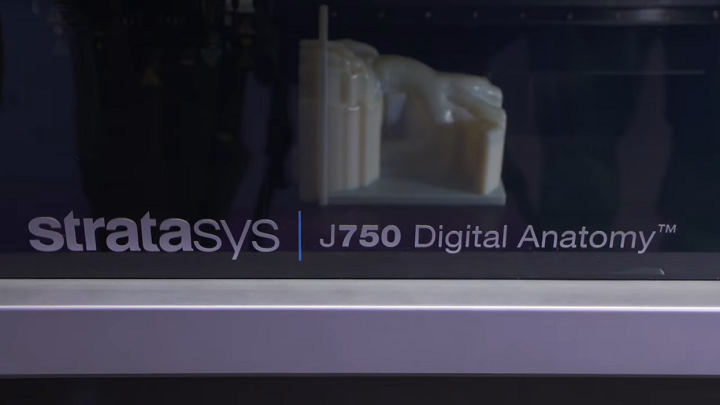One type of application for which polymer 3D printing leader Stratasys (NASDAQ: SSYS) is well known is medical, whether it’s using VR and 3D printed models to help separate conjoined twins, 3D printing devices for head lice treatment, and more. Recently, the company announced that it is sponsoring the University of Minnesota Visible Heart Laboratories with donations of its 3D printers. This large research lab, located at the university’s Medical School, supports both student and physician education, in addition to medical research and medical device product development and testing, and will use the donated Stratasys J750 Digital Anatomy, MakerBot METHOD X, and MakerBot SKETCH 3D printers for all of these applications.
“We believe that widespread use of 3D printed anatomic models in healthcare would translate into better and more cost-effective patient care and shorter time to market for new medical device innovations. This sponsorship allows us to support the world-class education and medical device research happening right here in Minnesota. At Stratasys, we recognize the importance of supporting the communities in which we live and work, and we are proud to support the University of Minnesota Visible Heart Laboratories and the work they are doing,” said Rich Garrity, President, Americas for Stratasys.
Every medical student at the University of Minnesota goes through the Visible Heart Laboratories in order to learn about how anatomic models—particularly 3D printed ones—can be extremely beneficial tools. Students from middle school age to clinical cardiologists also receive outreach education from the Visible Heart Laboratories about cardiac anatomy and device therapy, and the research labs also house the University of Minnesota Atlas of Human Cardiac Anatomy, which is a collection of over 800 human hearts that can be recreated with 3D printing for the purposes of education and medical device development and testing.
“We are thankful for those who have donated their heart to the Visible Heart Laboratories, these gifts have allowed the lab to give the gift of life to others. Mixed reality education utilizing high resolution 3D printing greatly impacts our abilities to better educate residents, fellows, medical students, biomedical engineers and many others,” said Dr. Paul Iaizzo, Professor at Visible Heart Laboratories.
Stratasys Digital Anatomy 3D printers are said to be able to fabricate extremely lifelike anatomic models that feel like the original human anatomy, as well as replicating the biomechanics and responsiveness of the actual organs. Students and physicians can actually puncture and cut the 3D printed models, then suture them back up, handling them just like real human tissue—obviously very important to the researchers, product developers, and students in the Visible Heart Laboratories.
These donated 3D printers will also be used to support research for various coronary medical device applications, as well as teach students. Also, physicians at the M Health Fairview University of Minnesota Medical Center will use them to teach their patients. It can be scary to prepare for surgery without a clear idea of what’s going on in your body and why, and lifelike, patient-specific, 3D printed anatomic models that represent a person’s comorbidities, demographics, pathology, and anatomic details, like tumors or plaque in an artery, can really help the patients better understand. Physicians can use the models to describe a patient’s treatment and surgical options, and also use them to prepare for the surgery ahead of time. All of this can reduce surgery time, result in better patient outcomes, and lower costs for hospitals and other healthcare facilities.

Dr. Iaizzo shows how a 3D printed anatomic model can be used for medical device testing. Credit: U of M Medical School | Visible Heart Laboratories
Dr. Iaizzo said, “The Visible Heart Laboratories are driven to train the next generation of medical device developers and provide them with the abilities to 3D print prototypes and/or virtually placed devices within real heart anatomies, as today these are considered essential skills.”
If you’d like to know more about this generous 3D printer donation from Stratasys, you can check out the video here.
Featured image: Students look at a 3D printed anatomic model in the University of Minnesota Visible Heart Laboratories. Credit: U of M Medical School | Visible Heart Laboratories
Subscribe to Our Email Newsletter
Stay up-to-date on all the latest news from the 3D printing industry and receive information and offers from third party vendors.
You May Also Like
3D Printing Financials: Fathom Struggles in Financial Quicksand During Critical Transition
Facing a year of key transitions and financial pressures, Fathom (Nasdaq: FTHM) has filed its annual report for 2023 with the U.S. Securities and Exchange Commission (SEC). The document outlines...
Latest Earnings Overview for Australian 3D Printing Firms Titomic and AML3D
Australian 3D printing manufacturing firms Titomic (ASX: TTT) and AML3D (ASX: AL3) reported their financial results for the period from July to December 2023, marking the first half of their...
3D Printing Webinar and Event Roundup: April 7, 2024
Webinars and events in the 3D printing industry are picking back up this week! Sea-Air-Space is coming to Maryland, and SAE International is sponsoring a 3D Systems webinar about 3D...
3D Printing Financials: Unpacking Farsoon and BLT’s 2023 Performance
In the Chinese 3D printing industry, two companies, Farsoon (SHA: 688433) and Bright Laser Technologies, or BLT (SHA: 688333), have recently unveiled their full-year earnings for 2023. Farsoon reported increases...

































